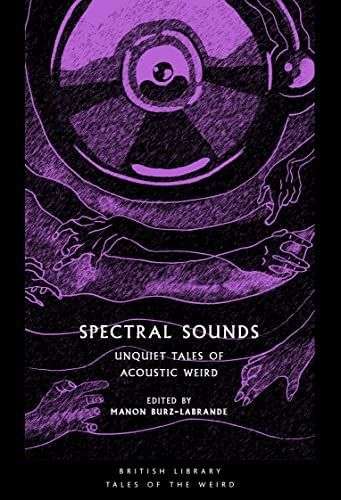SPECTRAL SOUNDS Unquiet tales of Acoustic Weird edited by Manon Burz-Labrande
British Library Press, 315-page p/b, £9.99
Reviewed by Pauline Morgan

The majority of reported ghost sightings are visual. They may be accompanied by effects on the other senses. Séances contacted the spirits of the dead and often relied on sounds to indicate their presence. There may be the touch of a ghostly hand or a scent wafting through the room (rarely is there the taste of a ghostly presence). In this volume, the editor has selected stories that have sound as the principal indication of a supernatural presence. They are divided into sections indicating the main types of auditory phenomena that accompany a haunting. As with the contents of other volumes reprinting weird stories from the British Library collections, these reflect the times in which they were written and all of these were originally published more than a hundred years ago.
The first group of stories involve the sounds that would normally be associated with the everyday activities of the living, but in these cases, there is no one in evidence. In ‘The Invisible Tenants of Rushmere’ by Florence Marryat (1883), the haunting is manifested by footsteps heard in the passageways at night. They appear to be re-enacting a tragedy that happened in the house at an earlier time. In ‘The First Comer’ by B. M. Croker (1896), the mysterious sound is that of someone lighting a fire. The story told is that this is a harbinger of death for the first person to enter the room after the sounds are heard. ‘The Day Of My Death’ by Elizabeth Stuart Phelps (1868) is a more complex story. It begins with mysterious knockings by an unseen presence which leads to the fascination with spiritualists by the narrator. The spirit at the séance predicts the narrator’s death
Whereas the first section relates to noises, the next stories eavesdrop on ghostly conversations. ‘The Spirit’s Whisper’ by Unknown (1868) has the narrator being spoken to by an invisible person. Although he thinks he might be hallucinating, the voice is irresistible, and it leads to him uncovering a wife murderer. In ‘A Case Of Eavesdropping’ by Algernon Blackwood (1906), Jim Shorthouse is told that there is no one else on the floor where he takes lodging, yet he clearly hears voices in the next room and is the aural witness to a murder that he discovers was committed some years before. Sometimes more than one sense is involved in the haunting, as in ‘A Speakin’ Ghost’ by Annie Trumbull Slosson (1890). Here, the narrator is visited by a boy who wants to recite to her. Initially, she thinks it is a real boy, but even when she realises it is a ghost, she is determined to teach him about Christian values so that he can move on to his next life. ‘The Whispering Wall’ by H. D Everett (1916) has a very different voice. At certain times, sounds run along a wall in an old house, and sometimes they manifest as words. It’s only at the end of the story that the words make sense. In ‘No Living Voice’ by Thomas Street Millington (1872), it is spectral groaning that awakens the narrator and, as a result, probably saves his life.
Man-made instruments can be a source of sound and haven’t been neglected by writers of weird stories. In ‘The Lady’s Maid’s Bell’ by Edith Wharton (1902), it is the communication system that was commonly used in larger country houses to summon servants. The narrator has taken a position as a lady’s maid, but it is the protective ghost of the previous incumbent who rings the bell. A church organ produces the sounds in ‘The Haunted Organist Of Hurley Burly’ by Rosa Mulholland (1886). Because he played a profane tune at a funeral, the squire’s son was cursed to play the organ until he died. Twenty years after his death, his ghost persuades a young woman to do the same with tragic results. The other two stories in this section both involve telephones. In ‘The Case Of Vincent Pyrwhit’ by Barry Pain (1901), a disconnected telephone rings, and Vincent Pyrwhit is sent a warning of his imminent death by his deceased wife. In ‘Over The Wires’ by H. D. Everett (1920), there is a conversation between a man and his fiancée. It later transpires that she was already dead when the call came.
The absence of sound can be as equally unsettling as strange noises. This is explored in ‘Siope – A Fable’ by Edgar Allan Poe (1837). In contrast, ‘The House Of Sounds’ by M. P. Shiel (1911) relates the last days of a 500-year-old house on a remote Scandinavian island. The inexplicable sounds form a cacophony enough to drive a man out of his mind.
Like all these British Library anthologies, this provides an insight into the influences and creativity of early writers of weird fiction.

